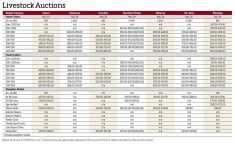In seeing reduced numbers of cattle coming to auction, Scott Anderson of Winnipeg Livestock Sales noted “the quiet time of the year” has begun.
“A lot of guys have either turned their cattle out or are just trying to get going on the land,” Anderson said.
In terms of quality, he said the ordinary cattle or plain cattle have not been as numerous recently. “There’s certainly a pretty wide gap between the top end and the bottom end.”
As for prices, those at Winnipeg were quite steady from week to week, with very few notable changes. The most obvious came in the 800- to 900-lb. feeder steers, which had sold for $176-$203 per hundredweight on May 13; a week later they fetched $165-$191/cwt.
Read Also

VIDEO: Watering system a cattle health win
Portable livestock watering system helps Manitoba beef producer combat foot rot cases on pasture.
Otherwise, prices remained firm, with 600- to 700-lb. feeder steers, for example, having sold for $190-$220.50/cwt on May 13, shifting slightly on May 20 to $193-$220.
It’s largely the same story for feeder heifers. The 600- to 700-pounders, which brought in $167-$192 at the previous auction, went for $165-$194 on May 20.
Going forward, Anderson said cattle volumes on the whole will continue to decline. On May 13, Winnipeg sold 870 head, which pulled back to 625 a week later. Ahead of the May 27 auction, Anderson said he expected about 450 cattle.
Throughout the eight cattle auctions, 5,783 cattle were sold last week, for an average of 723 head per site. This week, with six auctions, there were 4,760 cattle sold, averaging 793 head — the anomaly being the Virden auction, which saw the number of head spike from 787 on May 19 to 1,671 on May 26.
While wet conditions throughout the province have put a severe crimp in the amount of spring planting already completed, some progress continued to be made.
“Once (farmers) get the wheels turning, they don’t want to stop to haul cattle,” Anderson said.
While there have been some strong fluctuations in the Canadian dollar recently, Anderson pointed to another factor having far more of an effect on Manitoba cattle heading to the United States.
“It’s been very hard to find trucks to go south or anyone from the south who would send trucks up. There is cattle going that way, just not as many as there would have been prior to COVID-19,” he said.
Feed costs as well have been pressuring cattle prices.
“They got to be bought cheaper in order to compensate for the cost of the feed that’s going into them,” Anderson said.
Holsteins and other similar types of cattle have been receiving discounts more than they would have at least a year ago, he added.
Due to significant shortages, feed prices throughout Western Canada have risen sharply over the last 12 months. Barley has climbed $12.60-$14 per bushel delivered, according to Prairie Ag Hotwire. Feed wheat increased $5.66-$6.61/bu. over the same time.
“It’s the cost of getting them fat,” Anderson quipped.
















